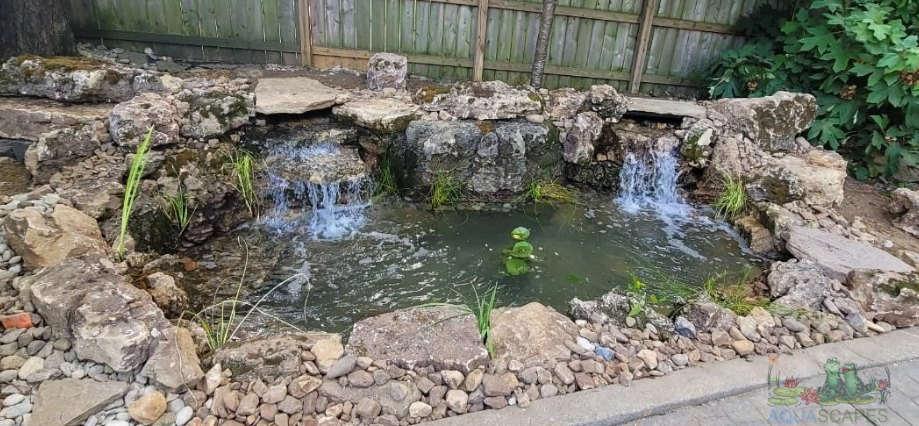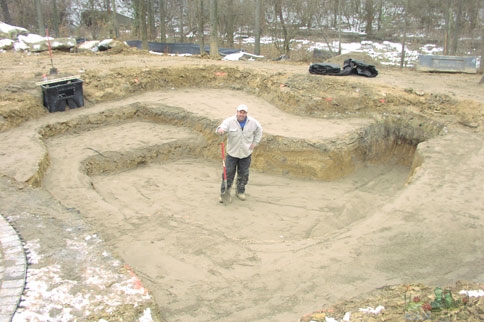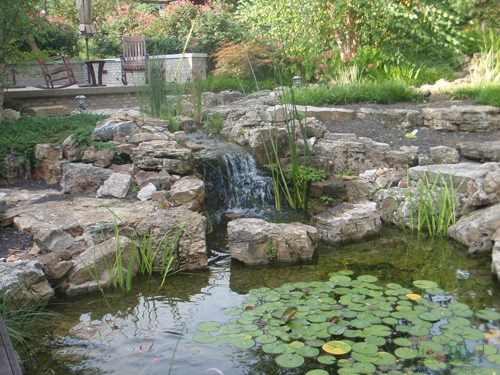How Deep Should My Pond Be?
There are many pond design options to choose from, but pond depth is one of the most important elements when designing a pond. First, let’s discuss how deep your pond should be.
Advantages and Disadvantages of Various Pond Depths
Shallow ponds (less than 2 feet) allow sunlight to reach the water’s floor producing healthy plant communities; however, they may need frequent cleaning because fish waste and excess nutrients accumulate in this pond bottom region. Also, shallow ponds attract geese which can make for messy conditions. Shallow ponds also don’t provide much space for fish to establish territories or grow big enough to avoid predators. It’s best to keep these pond depths less than 6 inches deep (you’re probably thinking “I can’t even sit in that pond!”).
Medium pond depths are the most popular among pond enthusiasts. A depth between 2-4 feet is generally accepted as best for all pond plants and animals. This depth allows enough height to support plant communities containing oxygenating plants while also providing ample fish habitat with plenty of room for plants, fish, waterfowl, insects, etc.
Deep ponds (greater than 4 feet) have similar species composition to shallow ponds because sunlight does not penetrate very deep into pond water, however, they can provide superior fishing habitat compared to standard pond depths because of their increased fish size capacity. Also, deep ponds are less susceptible to algae blooms due to restricted access by submersed weed species that grow rapidly in shallow pond conditions. Deep pond depths are generally not recommended for small ponds due to increased maintenance costs.
This pond depth chart below is a good starting point when pond designing your pond, but remember that it’s just a guide! You can have deeper or shallower ponds than the ones shown, but you’ll need to adjust your feeding program accordingly. If you continue feeding once fish get big enough to eat minnows, they may overpopulate your pond and start eating all their young.
Establishing Fish Habitat
Remember that fish habitat consists of more than just pond depth – water quality (i.e., oxygen levels, temperature fluctuations), bottom substrate composition (mud vs sand), plant density, availability (do I feed them?), and pond shape all play a role in pond habitat quality.
Pond water quality is probably the most influential factor on pond habitat quality, which means you need to know your pond’s nitrogen cycle! If you don’t currently have a pond – before getting any fish – make sure your local pond supply store has at least one test kit that measures ammonia, nitrite, and/or nitrate levels. You can also contact your state agricultural extension office for suggestions as well as take a day-long pond ecology class from a local pond-building club or nature center.
In general, shallow ponds tend to have high concentrations of aquatic plants because they receive plenty of sunlight whereas deep ponds tend to lack abundant plant growth due to lower light penetration. In pond landscapes with excess nutrients, plant growth typically benefits from increased depth as pond plants utilize available sunlight and nutrients. In pond settings where the pond is too nutrient-poor for most aquatic plants to thrive, shallow water levels can help reduce algae blooms by restricting access of submersed weed species known for their rapid proliferation in conditions that allow them to grow above pond surfaces.
Pond shape is another important design consideration. If you build a pond with a rectangular or square outline, you have two pond edges – called “bays” – which provide high fish habitat value because they’re usually quite deep and safe from predation. However, these bays may seem less appealing to some fish species such as koi who prefer large open areas with few pond structure elements for refuge.
To get around pond design issues similar to the one mentioned above, some pond owners build their pond with a pond inlet and pond outlet (mentioned later in the article). This allows pond water to circulate and brings new water from another source (such as river or stream), which is beneficial for fish habitat diversity and plant health because it increases oxygen levels and reduces nutrient accumulation within pond substrate.
Building Your Pond
A typical small backyard pond is made of concrete, rock, wood, etc. If you don’t mind spending a little extra time on construction (and having more things to clean), consider using larger stones collected from your pond site instead of smaller ones that may shift over time. Larger rocks will anchor themselves better into pond substrate, which means they won’t shift around over time and create unwanted pond structure elements that fish can get stuck in. Note: the right pond shape will minimize pond edge movement where your pond substrate meets water!
When it comes to pond depth design, always excavate below the frost line. This depth is dictated by your area’s average annual minimum temperature. If you build a pond 2 feet deep when there are 50 inches of snow in your region during winter, one day in January the temperature drops well below freezing for 24 hours. The result? Ice in your pond! And not just a thin layer either – this much ice will likely be at least 4 inches thick, which means you’ve just lost 1/3 of your total pond depth! After removing this much pond water, the pond will likely become a muddy mess during rainy seasons. To avoid pond icing, make sure to build a pond deep enough so that it never freezes solid in wintertime.
The general rule of thumb is to keep pond depths between 4 and 5 feet for koi ponds and 3-5 feet for goldfish ponds. If you want some pond fish with unique requirements which tend to need deeper waters (for example: sturgeon), consider building your pond at least 8 feet deep. In terms of pond shape, the amount of perimeter bank available dictates how many levels – or “stages” – you can have within your pond both aesthetically and naturally. A single-level pond is fine if you plan on having koi or pond goldfish exclusively. But if you want mixed pond fish species, consider pond depth in conjunction with pond shape to accommodate a wider diversity within your pond and create natural barriers (such as deeper “islands”) where certain pond fish like to roam around and explore:
Pond Depth Design Tips
– The average depth of a large lake is approximately 20 feet deep; try to keep your pond at least 3 feet deeper than this for optimal pond health (and avoid wide variations in water levels such as flooding during rainy seasons).
– If you’re digging out the pond substrate yourself, remember that the larger stone you use when building the pond rim does not need to match perfectly because’s merely an aesthetic feature. The pond substrate is what your pond fish spend their time in, so be sure to use large pond friendly rocks!
– Consider having a pond depth range for different parts of your pond. For example: have areas where pond fish can bask at the water’s surface and also have deeper pond structure elements such as deep bay areas or hydroponic beds that provide more hiding spots for pond fish.
– If you plan on digging out a lot of your own pond substrate yourself, consider renting a mini excavator – they’re usually quite affordable if paid yearly vs. per hour and are well worth the money if you plan on building multiple koi ponds or large scale backyard ponds. You’ll save a ton of time by helping speed up excavation with those pond shovels!
– When pond shopping, keep in mind that some pond kits are not designed to handle pond fish species with large appetites. For example: koi have strong stomachs and will eat more than pond goldfish so you need to be sure you can accommodate their pond food requirements before buying a pond kit for koi only. Otherwise they’ll become malnourished over time due to lack of proper nutrition.
– If you’re planning on having multiple levels within your pond don’t build the pond too deep upfront because some pond fish including goldfish aren’t very good swimmers and can get thrown off balance or injure themselves if there’s too much depth for them to keep upright during these dark winter months (especially if pond ice forms).
– To make pond depth calculations easier, keep in mind that 1 inch of pond depth is equal to 2.54 centimeters (cm).
– Consider having one or more ponds if you plan on running a backyard pond farm. They can be quite helpful for various pond management tasks including: pond cleaning, harvesting pond fish, applying pond algae treatments, feeding pond fish special pond foods that are not automatically added into the pond water by your waterfall filter system, etc.
As mentioned above, within certain size limits koi and other pond fish naturally enjoy deeper waters during wintertime where it’s typically warmer than shallow parts of the pond. However, if your winters are long and cold, you have no choice but to keep the entire pond frozen over to keep pond fish healthy and alive. Pond fishing pond de-icer products (like the pond de-icer shown on the right or this pond de-icer ) can help solve this problem, but they do require electricity and typically aren’t necessary if you only plan on having a pond that’s 8 feet deep or less.
Koi Fish Pond Depth
One of the best pond de-icers for ponds up to 1/2 acre in size is the pond de-icer shown on the left; it provides excellent automatic pond ice prevention as long as your winters are mild enough for at least some of your pond water surface areas not to freeze over! Thanks for reading – hope this helps! If you have any tips, comments or questions please post them below.
– pond depth is a very important pond design consideration because both too much and too little pond depth can cause problems for pond fish including koi, pond goldfish, and other pond fish species.
– pond depth can be increased by adding pond water, however trying to decrease pond depth is a much more difficult pond design problem and typically requires either: digging out your pond substrate and then filling in the pond with excess soil or some other type of heavy pond substrate instead of just water; this not only makes it harder for you to add fish but can also add too many nutrients into your pond. This happens when pond fish waste breaks down and feeds algae blooms within your pond’s nutrient solution zone, which impacts overall pond health and reduces fish pond oxygen levels.
– Pond Deeper Than 8 Feet: if your pond is deeper than 8 feet then be sure that most of the time there will not be thick ice covering at least 2/3 of your pond’s surface area for more than 3 or 4 consecutive weeks during the depths of winter. If pond ice does cover over 75 percent of your pond for this length of time it can begin to seriously stress pond fish.
Thanks for reading at Meyer Aquascapes! We hope you’ve enjoyed our post on garden pond design. Please leave a comment below if you liked it or have any questions. We’d love to hear from you! Thanks for stopping by!





 Meyer Aquascapes
Meyer Aquascapes